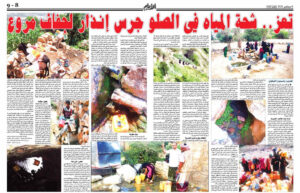Prepared by: Omnia Taher Jadallah
-Stockholm Declaration and Earth Summit
He first started talking about the environment – which is inextricably intertwined with climate change[1]He was at the Stockholm Summit in Sweden in 1972, which ended with the Stockholm Declaration, which included a preamble, seven appeals, and 26 principles. This was followed by the “Earth Summit” held in Rio de Janeiro, Brazil, in 1992[2] Containing the preamble and 27 principles[3]As conferences with diplomatic representation, both declarations constituted instruments that were not formally binding on participating states, but they formed the nucleus of environmental law at the international level.
-International Framework Convention on Climate Change
This was followed by the emergence of the first international climate change agreement, the UNFCC (1992), which Egypt ratified in 1994. It was ratified by 198 countries. The United Nations Framework Convention on Climate Change borrowed a crucial sentence from one of the most successful multilateral environmental treaties (the 1987 Montreal Protocol on Substances that Deplete the Ozone Layer). It obliges member states to act in the interest of human safety even in the face of scientific uncertainty, as development has not Scientific knowledge at that time had not yet reached its peak, and the sources and tools were not previously available as they are now.
The ultimate goal of the agreement is to stabilize concentrations of greenhouse gases/thermal/carbon emissions “at a level that prevents dangerous human interference with the climate system.” It states that “this level should be achieved within a sufficient time frame to allow ecosystems to adapt naturally to climate change, to ensure that food production is not threatened, and to enable economic development to proceed in a sustainable manner.” Industrialized countries also agree under the agreement to support climate change activities in developing countries by providing financial support for action on climate change – beyond any financial assistance they already provide to these countries. A system of grants and loans has been established through the Convention and is managed by the Global Environment Facility[4]. Industrialized countries also agree to share technology with less developed countries. Industrialized countries are required to report regularly on their climate change policies and measures, including issues governed by the Kyoto Protocol (for countries that have ratified it). They must also provide an annual inventory of their heat/carbon emissions, including data for the base year (1990) and all years thereafter. In contrast, developing countries report more generally on the actions they have taken to address climate change and adapt to its impacts – but less regularly than developed country Parties do, and their reports depend on their obtaining the necessary funding to prepare these reports, especially in the case of least developed countries. The agreement recognizes the vulnerability of all countries to the impacts of climate change.
-Kyoto Protocol
This agreement was followed by the issuance of the Kyoto Protocol [5]1997, which entered into force in 2005, which operationalizes the United Nations Framework Convention on Climate Change by requiring industrialized countries and economies in transition to limit and reduce greenhouse gas emissions in accordance with agreed individual targets. The Convention itself only requires those countries to adopt mitigation policies and measures and to submit periodic reports.[6] The Protocol only binds developed countries, placing a heavier burden on them under the principle of “common but differentiated responsibility and respective capabilities,” because it recognizes that they are largely responsible for the current high levels of greenhouse gas emissions in the atmosphere.[7] In Doha, Qatar 2012, the Doha Amendment to the Kyoto Protocol was adopted for a second commitment period starting in 2013 and continuing until 2020. As of 28 October 2020, 147 Parties had deposited their instruments of acceptance, thus reaching the threshold of 144 instruments of acceptance for the entry into force of the Doha Amendment. The amendment entered into force on December 31, 2020. There are currently 192 parties to the Kyoto Protocol.
-Paris Agreement
This was followed by the issuance of many different declarations and policies until the 2015 Paris Climate Change Agreement came, and Egypt ratified it in 2017. Ratification is what concerns us, as it is the step by which the agreement enters into force, and from its date, the commitment of the states parties to it begins in accordance with the rules of international law. It aims to periodically evaluate collective progress towards achieving its purpose and long-term goals and provide financing to developing countries to mitigate the effects of climate change, enhance resilience and enhance capacities to adapt to climate impacts.
The Paris Agreement is criticized for not being accompanied by sanctions in the event of violation, which makes it a soft law rather than a binding international agreement, and its implementation depends on the political will of the states parties. For example, former United States President Trump decided to withdraw from the Paris Agreement until current President Biden came and rejoined the agreement. Which explains why the world is behind at a rate of 23 million tons of carbon that was supposed to be phased out. In addition, many of the materials are scientifically formulated in a way that is difficult for non-technical people to deal with. An obstacle is also the very high cost of greening industries and energy due to the high prices of its technology, as well as the financing gap necessary to provide those huge budgets to spend on the plans and policies adopted by countries at conferences of states parties every year, the most recent of which is COP28 in the Emirates. For example, the United Nations Programme United Environment has a gap in financing only the adaptation program launched by the Paris Agreement - unlike other programs required to be implemented - of about $387 billion.[8] I previously personally participated in the United Nations International Law Program in Geneva in July 2023, and I submitted, along with legal experts, a proposal to the United Nations International Law Committee to overcome the soft nature of the agreement, but the discussion has always been that diplomatic methods always stand in the way of that.[9].
-Cancun Agreement
Then came the first UNFCCC document to indicate a limit to global warming of 1.5°C, the Cancun Agreement, which was adopted at the sixteenth session of the Conference of the Parties (COP16) in 2010. The Cancun Agreement established a process for periodically reviewing “the adequacy of “Long-Term Global Goal” (LTGG) in light of the ultimate goal of the Convention and the overall progress made towards achieving the LTGG, including consideration of the implementation of obligations under the Convention. The definition of LTGG in the Cancun Agreement was “keeping the increase in global average temperature below 2°C above pre-industrial levels.” The agreement also recognized the need to consider “promoting the long-term global goal on the basis of the best available scientific knowledge to reach a global average temperature rise of 1.5 degrees Celsius.”[10] The Adaptation Committee, which Parties agreed to establish under the Cancun Adaptation Framework as part of the Cancun Agreements, constitutes a major step towards a coherent and Convention-based approach to adaptation.[11]
Many international agreements and treaties have also been issued to regulate all environmental aspects, including the Convention on Biological Diversity. The Convention on the Transboundary Effects of Industrial Accidents and the Declaration of Principles for Forest Governance, the establishment of the Commission on Sustainable Development, the First World Conference on the Sustainable Development of Small Island Developing States in 1994, the Fish Stocks and Aquatic Wildlife Agreements and many others. The most recent of these agreements is the Convention on Marine Biodiversity Beyond National Jurisdiction (BBNJ) 2023. [12]. In addition, there are attempts to codify environmental protection in times of armed conflict, and a report was issued by the United Nations International Law Commission[13]This requires consideration and study now, especially with the bloody humanitarian and environmental violations committed by the Zionist entity in occupied Palestine, in violation of all binding international agreements in this regard, the impact of which is not limited only to the Palestinian territories, but also to neighboring countries and the entire public space.
-Global Environment Charter
In order to fill the existing gaps in international environmental law formed by the aforementioned international agreements and others, the French government launched in 2017 the “Global Charter for the Environment[14]“For the world to move towards adopting a legally binding international instrument. The Charter is a draft international treaty that aims to recognize a new generation of basic rights and duties related to environmental protection, in particular, the right to a healthy environment. While many countries support its adoption, a few countries strongly oppose it. For this reason, the Charter called on civil society to join forces to demand that countries recognize environmental human rights and protect the environment. To this end, the Charter Project launched a major coalition bringing together NGOs, activists, artists, citizens, lawyers, and scholars called the “Global Charter Alliance.”
In order to coordinate international action and to reach the desired climate goals, the United Nations established a special environmental organization, United Nations Environment, in 2012, based in Nairobi, Kenya, Africa.[15]. Days have also been allocated annually, such as World Environment Day, World Oceans Day, World Sea Green Day, World Water Day, and others, as an occasion to highlight the importance of the rational use of natural resources, awareness of climate change issues, and individuals’ positive behavior toward those issues that affect our lives.
Then he started talking about the rule of environmental law as a fundamental matter for sustainable development. It integrates environmental needs with basic elements of the rule of law, and provides the basis for improved environmental governance. The environmental rule of law report was issued by the United Nations [16] Highlighting environmental sustainability by linking it to basic rights and obligations. It reflects universal moral values and ethical codes of conduct, and provides the basis for environmental rights and obligations. Without the rule of environmental law and enforcement of legal rights and obligations, environmental management may be arbitrary, arbitrary, subjective and unpredictable.
In addition to climate justice, talk of environmental justice emerged and a report entitled “Environmental Justice – Comparative Experiences” was issued in Legal Empowerment, June 12, 2014. The report summarized the challenges and innovations emerging around the world. The report also highlights trends in emerging strategies across regions (Asia and the Pacific). , Arab countries, Africa, Latin America and the Caribbean), including incorporating environmental principles into constitutions, as well as into national laws and regulations, and ensuring access to remedies through the courts in environmental matters, including the establishment of specialized environmental courts (Environmental.[17]
-Environmental laws
In implementation of everything stated in the international agreements concerned with the rule of environmental law and in the hope of achieving climate and environmental justice, some countries - especially the most affected countries - have taken the initiative to make efforts within an international legal framework to combat climate change and resort to international courts to give it a mandatory character that constitutes a soft legalization of obligations towards climate change in view of To the grave dangers they are experiencing and claiming their fate and the fates of their people, as the rise of sea levels, the melting of huge ice masses, forest fires as a result of high temperatures, and others have constituted an alarm bell and a strong threat to many countries that are suffering from these disasters in an unprecedented way, and these attempts are as follows:
(a) Chile and Colombia submitted a request for an advisory opinion in the Inter-American Court of Human Rights (IACthR) on the scope of State obligations in relation to climate change on 9 January 2023, in particular with regard to common and contingent responsibilities between countries. The first pleading sessions will be held on April 23, 24, and 25, 2024, and the sessions will be completed on May 27, 28, and 29. [18] From this year. The Sabin Center for Climate Change Law - Columbia University is working to summarize the memorandums that were submitted before the court, and we will share the report with you after its release.
(b) The Committee on Small Island States on Climate Change and International Law (COSIS), which is suffering from the consequences of climate change, led by Venuatu, one of the small island states, submitted a request for an advisory opinion from the United Nations International Tribunal for the Law of the Sea (ITLOS) - based in Germany - Hamburg - In December 2022, the request addresses the obligations of States Parties to the United Nations Convention on the Law of the Sea to prevent, reduce, control, conserve and protect pollution of the marine environment in relation to the impacts of climate change. The pleading sessions for the advisory opinion were held in September 2023. The pleading sessions were held before the United Nations Tribunal for the International Law of the Sea, and countries (including Egypt) submitted[19]International organizations and civil society submitted memorandums to it[20]The Sabin Center for Climate Change Law - Columbia University has summarized the briefs presented before the court in this report[21]. The Climate School will Arabize what was stated with the most important legal arguments contained in it and share them with you.
(c) The United Nations General Assembly (UNGA) unanimously adopted a resolution raising a set of questions about the responsibilities of states regarding climate change to the International Court of Justice (ICJ) in March 2023, and what will be presented before it in this regard is awaited.
In addition, an initiative by African civil society institutions expressed its intention to request an advisory opinion from the African Court on Human and Peoples’ Rights (based in Arusha - Tanzania) regarding the human rights obligations of African countries with regard to the effects of climate change, as the continent of Africa is the continent most affected by climate change. Although it contributes the least to heat emissions (the People's Republic of China and the United States of America are the most polluting). However, this initiative has not yet seen the light. It is worth noting that the African Charter on Human and Peoples’ Rights is the first declaration that stipulates the human right to a clean, healthy environment [22].
There is skepticism about the usefulness of these advisory opinions because they are non-binding, but in any case they will outline the framework of obligations and rights for countries, especially the countries most affected by the consequences of climate change. However, the academic and practical scientific and legal communities place their hopes in the advisory opinion of the United Nations Tribunal for the International Law of the Sea as a specialized court with well-versed judges with scientific and practical experience in the international law of the sea. I imagine that these advisory opinions, once they define the obligations of states, will be a basis for many issues in this regard, and that they will continue to be cited in disputes and claims between states as a soft law, and with time it will become customary and binding.[23]
Climate and environmental justice will remain the real challenge of the current century, on which the fate of all humanity will depend. Each of us has a role to play in this matter - regardless of our levels of awareness - while not underestimating its simplicity. The first of those roles is to increase knowledge and demand that governments act and adhere to what is stated in the agreements to preserve... The future of all humanity, and educating our society about the consequences of climate change and what we can do in the situations we are exposed to daily...which is what the Climate School will share with you in the upcoming articles..
About Taher Jadallah’s wish:

Assistant lecturer in commercial law at Al-Azhar University and doctoral researcher
Master of Laws - University of Cambridge, founder of the Right Platform Initiative, and volunteer at the Climate School.
List of references used:
[1] Everything that positively affects the environment is affected by the climate, and vice versa. Everything that negatively affects the climate is also affected negatively by the environment.
[2] https://www.un.org/ar/conferences/environment/rio1992
[3] Principles version in Arabic
https://documents.un.org/doc/undoc/gen/n92/836/53/img/n9283653.pdf?token=uTPebaczZEukh1ABkD&fe=true
The principles version in English
https://www.iau-hesd.net/sites/default/files/documents/rio_e.pdf
[5] https://unfccc.int/kyoto_protocol
[6] https://unfccc.int/process-and-meetings/what-is-the-united-nations-framework-convention-on-climate-change
[7] In Annex B of the Protocol, the Kyoto Protocol sets binding emissions reduction targets for 37 industrialized and transitional economies and the European Union. Overall, these targets add up to an average emissions reduction of 5 percent compared to 1990 levels over the five-year period 2008-2012 (the first commitment period).
[8] https://www.facebook.com/omnia.tahergadalla/posts/pfbid0kYA7eirA4DsdkcDSDmsoZuz5yC2DLTdsimFvBPn2GHbW7EjbEBdmgxQr9LjrvWDpl
[9] https://legal.un.org/ilc/reports/2023/
https://legal.un.org/ilc/reports/2023/english/chp10.pdf
[10] The Intergovernmental Panel on Climate Change (IPCC), the United Nations body for science related to climate change, is the most cited and in-depth scientific and technical report, but it is hundreds of pages long.
https://www.ipcc.ch/sr15/faq/faq-chapter-1/
[11] https://unfccc.int/process-and-meetings/what-is-the-united-nations-framework-convention-on-climate-change
[13] https://legal.un.org/ilc/guide/8_7.shtml
[14] https://globalpactenvironment.org/en/
[15] https://www.unep.org/topics/disasters-and-conflicts/country-presence/kenya
[16] https://www.unep.org/ar/explore-topics/environmental-rights-and-governance/what-we-do/syadt-alqanwn-albyyy
[17] https://www.undp.org/publications/environmental-justice-comparative-experiences-legal-empowerment
https://www.corteidh.or.cr/index.cfm?lang=en
https://corteidh.or.cr/docs/asuntos/solicitud_22_02_2024_eng.pdf
[19] https://www.itlos.org/fileadmin/itlos/documents/cases/31/written_statements/1/C31-WS-1-17-Egypt.pdf
[20] https://www.itlos.org/en/main/cases/list-of-cases/request-for-an-advisory-opinion-submitted-by-the-commission-of-small-island-states-on-climate-change-and-international-law-request-for-advisory-opinion-submitted-to-the-tribunal/
[21] https://scholarship.law.columbia.edu/sabin_climate_change/208/
[22] https://www.oas.org/en/sla/dil/docs/African_Charter_Human_Peoples_Rights.pdf





